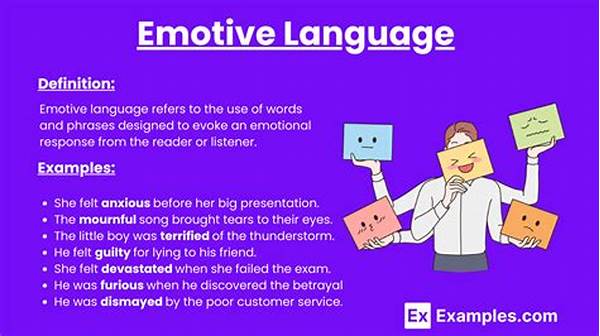In the digital age, communication has transcended boundaries, making emails a crucial tool for both personal and professional interactions. Among numerous aspects of email communication, emotive language emerges as a powerful influencer. Imagine opening an email that doesn’t just inform but stirs emotions – a sense of excitement, curiosity, or even nostalgia. This dynamic aspect of communication doesn’t merely transmit information but weaves a story and forges a connection. “Emotive language in emails” involves crafting messages that facilitate emotional engagement, leading to more effective communication. If you’ve ever felt joy from a “congratulations” in your inbox or warmth from a “thank you,” you’ve encountered emotive language.
The strategic application of emotive language can transform dull and forgettable messages into impactful communications that resonate with the recipient. It’s akin to adding color to a black-and-white canvas, bringing your words to life and making them memorable. This art not only captivates attention but can be pivotal in marketing, customer support, and everyday correspondence. In an era where inboxes are flooded with monotonous text, mastering emotive language in emails can be your unique selling point. Let’s delve into how this can boost your email strategy and elevate your communication game.
To engage fully with your audience, understanding the nuances of emotive language is essential. Whether it’s crafting your next marketing campaign or writing to a colleague, the power of words should not be underestimated. Picking the right words can mean the difference between an email that gets a quick glance and one that encourages action and interest. Utilizing emotive language in emails effectively not only requires a grasp of vocabulary but an empathy towards how those words will be received by others.
Imagine crafting an email that had the reader eagerly anticipating the next paragraph, or maybe even chuckling at your well-placed humor. That’s the magic of emotive language at play, creating a seamless flow of information that entices rather than repels. When done right, this kind of communication can lead to deeper relationships, both personally and professionally, by building trust and understanding.
The Power of Emotionally Charged Words
The ability to evoke feelings through text is undoubtedly a skill that can reap rewards. You don’t need to be Shakespeare to harness this power; sometimes a simple, heartfelt message does the trick. Whether you’re selling a product or just connecting with friends and family, emotive language in emails can transform your written words into a memorable experience. Engage, excite, and connect—because every word counts.
—
Understanding how to effectively structure emotive language in emails can be your gateway to more meaningful interactions. In a world obsessed with efficiency, email remains a primary tool for communication, and email with emotional richness stands out. Below, we’ll explore the strategic structuring of emotive language in email communication.
Capturing attention is the first step in any successful email strategy. Begin with a captivating subject line that stirs curiosity or emotion. Incorporating emotive language in emails from the outset sets the tone and beckons the reader to dig deeper. Imagine receiving an email entitled “Unlock Joy” or “Your Exciting Journey Awaits” – immediate intrigue is sparked, inviting engagement.
Once the door to curiosity is opened, maintaining interest through personalized storytelling becomes vital. Customizing email content to reflect the recipient’s tastes or experiences not only sustains engagement but enhances emotional connection. This can be done through anecdotes or shared experiences, woven into the fabric of the email, keeping the narrative relatable and the reader invested.
Furthermore, invoke a sense of desire by addressing the needs or aspirations of your audience. Here, emotive language in emails becomes pivotal, sculpting emotions of wanting or longing for what’s being offered. It’s persuasive yet personal, making the reader feel seen and understood.
Ending with a clear call-to-action harnesses the emotional journey to prompt response. Whether it’s to explore a product, respond to an invitation, or simply continue the conversation, this final push anchors the emotive experience into tangible interaction. Effective calls-to-action are succinct and follow the emotive narrative, enhancing coherence and follow-through.
Techniques for Emotive Email Structuring
Focusing on the interplay between structure and language can elevate your communication strategy. Craft emails with emotive language by:
Crucial Elements of Emotive Language in Emails
Examining these strategies reveals emotive language in emails as a pivotal asset in cutting through the noise. Each email becomes more than a message – it becomes a connection, a testament to the power of well-crafted words and strategic emotional engagement to bridge gaps and foster relationships.
—
Understanding the key components of emotive language in emails can put your communication on another level. Here are seven critical elements:
The significance of emotive language in emails is indisputable. Learning to harness this power means moving beyond simply conveying information, to crafting experiences that engage and persuade, making each email occasion an event unto itself.
The Art of Engagement in Email Communication
Crafting an email is akin to painting a canvas—colors might represent excitement, lines might reflect tenderness, and the entire piece is curated for emotional effect. Emotive language in emails is the key to creating such artistry. Words capturing imagination, eloquently painting the narrative that entices the reader and offers a valuable experience. In this digital age, forming genuine connections through emails can mean the difference between a momentary glance and a lasting relationship.
Incorporating emotive language in emails transforms a routine task into a strategic endeavor, merging creativity with communication expertise. It’s more than a skill—it’s an art, one that rewards those willing to explore its depths.
Making Emotional Connections through Emails
To summarize, understanding and implementing emotive language in emails not only boosts communication but fosters genuine connection. Every word carries weight, commanding attention and building bridges through thoughtfully constructed emotional appeal. Explore this narrative art in your emails, and watch as your engagement metrics and relationships flourish.

